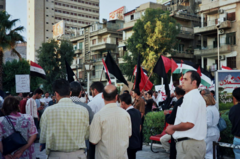Anarchism in Egypt
| Part of a series on |
| Anarchism |
|---|
 |
Anarchism in Egypt refers both to the historical Egyptian anarchist movement which emerged in the 1860s and lasted until the 1940s, and to the anarchist movement as it has re-emerged in the early 2000s. Anarchism was first introduced to Egypt by Italian immigrant workers and political exiles in the 1860s. The Italian community in Egypt was one of numerous such communities of expatriate workers whose presence in Egypt dated to the modernisation programme of
Many leading figures of the global anarchist movement, including Errico Malatesta, Amilcare Cipriani, Élisée Reclus, Luigi Galleani, and Pietro Gori passed through Egypt at various points and for various reasons, owing to its position as a relatively safe haven for political dissidents and close proximity to Europe. The movement re-entered global view when a number of anarchist groups took part in the 2011 Egyptian revolution, namely the Egyptian Libertarian Socialist Movement and Black Flag.[1]
History
Emergence: 1860s–1910s
Anarchism was first introduced to Egypt by Italian immigrant workers and political exiles in the 1860s. The Italian community in Egypt was one of numerous such communities of expatriate workers whose presence in Egypt dated to the modernisation programme of
The Italian Workers Society (Italian: Società Operaia Italiana), established in Alexandria in the early 1860s, was the first organisation among the Italian expatriate community which began to move towards anarchism. By the middle of the 1870s, the arrival of veterans of Giuseppe Garibaldi's campaigns and other radicals lead to the establishment of Thought and Action (Italian: Pensiero ed Azione), a political association along Mazzinian lines. In 1876, a more radical grouping split from this and was recognised as the official Alexandrine section of the anarchist First International. Additional sections were formed in Cairo, Port Said and Ismailia over the next year, and the Egyptian sections presented their first report to the International at its Verviers Congress in September 1877. Although at this, early stage the movement was strongly Italian in character, the published proceedings of the Verviers Congress demonstrate that the Alexandrine section, with the support of the one in Cairo, and the Greek Federation, successfully sponsored a proposal calling for the dissemination throughout the eastern Mediterranean of anarchist literature "in Italian, Illyrian, Greek, Turkish and Arabic". The International dissolved shortly after and the resolution came to nothing, but it clearly demonstrated the aspiration of the fledgling Egyptian anarchist movement to expand beyond its initial exclusively Italian base.[2]
Many leading figures of the global anarchist movement, including Errico Malatesta, Amilcare Cipriani, Élisée Reclus, Luigi Galleani, and Pietro Gori passed through Egypt at various points and for various reasons, owing to its position as a relatively safe haven for political dissidents and close proximity to Europe. In July 1881 when anarchist delegates convened in London to establish the International Working People's Association (or "Black International"), the Egyptian sections – in federation with anarchists in Istanbul – were represented by Malatesta, then resident in Egypt. By this time, the Alexandrine anarchists had established a European Social Studies Circle (Italian: Circolo europeo di studii sociali), in which they held discussions on social questions, and had set up a clandestine press for the printing of posters. Later in the same year a conference was convened at Sidi Gaber and attended by approximately 100 delegates from anarchist groups across Egypt.[2]
During much of this period, Egypt had been in a sustained political crisis. Egypt fell into heavy debt, incurred to fund extensive infrastructure development and the lavish lifestyle of the
Re-emergence: early 2010s–present

The movement re-entered the global view when a number of anarchist groups took part in the 2011 Egyptian revolution, namely the Egyptian Libertarian Socialist Movement and Black Flag.[3] The Egyptian anarchists have come under attack from the military regime and the Muslim Brotherhood.[4][5][6] On October 7, 2011, the Egyptian Libertarian Socialist Movement held its first conference in Cairo.[7]
Organisations
- Black Flag (2010s–)
- Libertarian Socialist Movement (2011–)
See also
References
- ^ Egypt unrest: Interview with an Egyptian anarchist
- ^ ISBN 978-9004188-49-5.
- ^ Egypt unrest: Interview with an Egyptian anarchist
- ^ Egyptian Anarchists and Revolutionary Socialists under attack
- ^ An Egyptian anarchist on the renewed revolution in Egypt
- ^ FEATURES: Anarchists: Preferably Stateless
- ^ "Anarchist: First Conference of Egypt's Libertarian Socialists (2011)". Archived from the original on 2015-05-05. Retrieved 2012-11-24.
Further reading
- Gorman, Anthony (2008). "Foreign workers in Egypt 1882–1914: subaltern or labour elite?". In Cronin, Stephanie (ed.). Subalterns and Social Protest: History from Below in the Middle East and North Africa. SOAS/Routledge studies on the Middle East. Vol. 7. ISBN 978-0-203-93926-0.
- Hernández, Laura Galián; Paonessa, Costantino (2018). "Caught between Internationalism, Transnationalism and Immigration: A Brief Account of the History of Anarchism in Egypt until 1945". ISSN 0967-3393.
